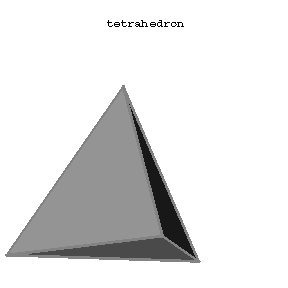Tetrahedron
From Encyclopedia of Mathematics
The printable version is no longer supported and may have rendering errors. Please update your browser bookmarks and please use the default browser print function instead.
The convex hull of a set of four points, not all in one plane. In particular, a regular tetrahedron is one of the five types of Platonic polyhedra (cf. Platonic solids). A tetrahedron has 4 (triangular) faces, 6 edges and 4 vertices (at each of which 3 edges meet). If  is the length of an edge of the regular tetrahedron, then its volume is
is the length of an edge of the regular tetrahedron, then its volume is
 |
A tetrahedron is a triangular pyramid.

Figure: t092510a
Comments
A solid tetrahedron is also called a  -simplex. The Schläfli symbol of a tetrahedron is
-simplex. The Schläfli symbol of a tetrahedron is  .
.
References
| [a1] | H.S.M. Coxeter, "Introduction to geometry" , Wiley (1969) pp. 149; 185 |
| [a2] | H. Senechal (ed.) G. Fleck (ed.) , Shaping space , Birkhäuser (1988) pp. 5; 7; 100; 133; 175 |
How to Cite This Entry:
Tetrahedron. Encyclopedia of Mathematics. URL: http://encyclopediaofmath.org/index.php?title=Tetrahedron&oldid=18299
Tetrahedron. Encyclopedia of Mathematics. URL: http://encyclopediaofmath.org/index.php?title=Tetrahedron&oldid=18299
This article was adapted from an original article by BSE-3 (originator), which appeared in Encyclopedia of Mathematics - ISBN 1402006098. See original article